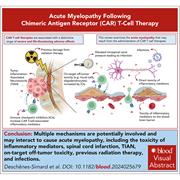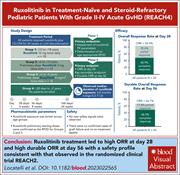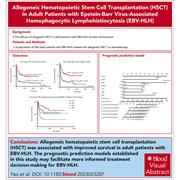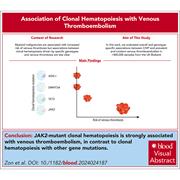Issue Archive
Table of Contents
BLOOD COMMENTARIES
Ruxolitinib REACHes FOR children with GVHD
Clinical Trials & Observations
PERSPECTIVE
Hemoglobin-based transfusion strategies for cardiovascular and other diseases: restrictive, liberal, or neither?
Clinical Trials & Observations
Natanson and colleagues provide a timely Perspective discussing the evidence for use of a hemoglobin value as a trigger for red blood cell transfusion in clinical practice guidelines, highlighting issues with trial design and interpretation. The authors argue in favor of rethinking the use of a restrictive strategy for transfusion triggered by a lower hemoglobin value, especially for patients with cardiovascular disease. For routine practice, they emphasize the importance of an approach that incorporates personalized assessment of risks rather than singular use of a trigger value. They also provide suggestions for future trial design and interpretation of outcome data.
REVIEW ARTICLE
Clinical features, pathophysiology, and management of acute myelopathy following CAR T-cell therapy
Acute myelopathy is a rare but devastating complication of chimeric antigen receptor (CAR) T-cell therapy for patients with hematological malignancies. Deschênes-Simard and coauthors review 24 published cases, highlighting key features to raise awareness and providing suggestions regarding management. As the pathophysiology of this often irreversible spinal cord injury remains largely unexplained, it is also a call for rigorous reporting and ongoing research.
CLINICAL TRIALS AND OBSERVATIONS
Ruxolitinib for pediatric patients with treatment-naïve and steroid-refractory acute graft-versus-host disease: the REACH4 study
Clinical Trials & Observations
Acute graft-versus-host disease (aGVHD) remains a major obstacle to successful allogeneic hematopoietic stem cell transplantation. Locatelli et al report the results of REACH4, an open-label, single-arm, international multicenter study evaluating the pharmacokinetics, efficacy, and safety of ruxolitinib in pediatric patients with grade 2 to 4 aGVHD. The data establish age-appropriate dosing and demonstrate that ruxolitinib is safe and effective for pediatric patients with either treatment-naïve or steroid-refractory GVHD. The optimal timing of use and any long-term consequences of use in young children require further study.
Transplantation in adult patients with Epstein-Barr virus–associated hemophagocytic lymphohistiocytosis: yes or no?
Clinical Trials & Observations
Epstein-Barr virus–associated hemophagocytic lymphohistiocytosis (EBV-HLH) is a consequence of aberrant immunological response to EBV infection and is especially common in Asia. Yao et al report on the outcomes of 356 patients with EBV-HLH treated at a single center between 2015 and 2021, with a median survival of less than 6 months. In multivariable analyses, higher survival was associated with allogeneic hematopoietic stem cell transplant, and a prediction model was established that may help therapeutic decision-making in this challenging group of patients.
LYMPHOID NEOPLASIA
Spatial transcriptomics reveals profound subclonal heterogeneity and T-cell dysfunction in extramedullary myeloma
When multiple myeloma grows outside the bone marrow as extramedullary disease (EMD), the prognosis for patients is worse. John and colleagues applied spatial transcriptomics augmented with protein and single-cell sequencing to gain insights into the complexity of EMD, studying both the malignant cells and the immune response. The authors report spatial differences in plasma cell subclones with varying expression of therapeutic targets, as well as distinct niches for both active and exhausted T cells, providing impetus for the development of dual-targeting strategies to enhance responsiveness to therapy.
PLATELETS AND THROMBOPOIESIS
YAP1 regulates thrombopoiesis by binding to MYH9 in immune thrombocytopenia
While the reason for low platelet counts in patients with immune thrombocytopenia (ITP) is typically thought to reflect the destruction of platelets, platelet production is in fact also impaired. Hu and colleagues explored this failure of compensatory thrombopoiesis, revealing a role for the GATA1-regulated transcription cofactor Yes-associated protein 1 (YAP1), whose expression was reduced in both megakaryocytes of patients with ITP and mice with antibody-induced ITP. The authors define how YAP1 cooperates with myosin heavy chain 9 (MYH9) to regulate actin cytoskeleton organization and platelet production, demonstrating a potential route to augmenting thrombopoiesis by megakaryocytes in ITP.
THROMBOSIS AND HEMOSTASIS
JAK2-mutant clonal hematopoiesis is associated with venous thromboembolism
An association between clonal hematopoiesis of indeterminate potential (CHIP) and venous thromboembolism (VTE) has been suggested in epidemiological studies. Zon et al evaluated CHIP genotype–specific associations with VTE in a very large general population data and sample set from the UK Biobank. After accounting for potentially undiagnosed myeloproliferative diseases, the authors established that JAK2-mutant CHIP was highly associated with risk of VTE, whereas TET2-mutated CHIP was only modestly associated; DNMT3A-mutated CHIP, the most common genotype, was unassociated with increased VTE risk.
BLOOD WORK
-
Cover Image
Cover Image
![issue cover]()
Immunofluorescence image of a cutaneous extramedullary myeloma lesion stained with α-CD3e (green), α-CD138 (red), and α-Collagen I (blue). Spatial transcriptomics reveal the coexistence of fit and exhausted T cells within these lesions. See the article by John et al on page 2121.
- PDF Icon Front MatterFront Matter
- PDF Icon Table of ContentsTable of Contents
- PDF Icon Editorial BoardEditorial Board
Advertisement intended for health care professionals
Email alerts
Advertisement intended for health care professionals








